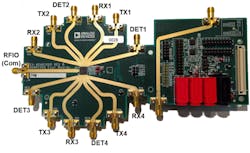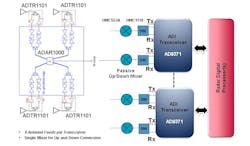Steerable radar systems use mechanical means to adjust a single antenna element. Phased-array radar utilizes multiple fixed antennas to perform a similar function. The challenge with phased beamforming is that the electronics must be replicated for each antenna within an array.
Analog Devices’ GaN-based ADAR1000 X/Ku band beamformer chip can handle four antennas at once (Fig. 1). The chip supports a frequency range from 8 to 16 GHz. Maximum operating gain is 20 dB for the transmit side and 9 dB for the receive side. It has 360-deg. phase control with a 2.8-deg. phase-control resolution and 31-dB gain control. A single pin handles the transmit/receive toggle. It fits in a 7- × 7-mm LGA package.
1. Analog Devices’ ADAR1000 X/Ku band beamformer can handle four antennas.
A typical 16-element antenna array would require four ADAR1000 chips (Fig. 2). The ICs, like the beamformer chips, are normally found on the back of the PCB, helping to reduce the size of the system. The result is a compact, low-profile phased-array radar system.
Phased-array systems have a number of benefits in addition to eliminating the mechanical aspects of the alternative. Beamsteering is normally faster and has the ability to create nulls that eliminate or mitigate jamming and interference. The system can fail gracefully if a single element is lost.
2. This 16-element antenna (left) would use four ADAR1000s on the back (right).
One of the challenges for tight integration is cooling. The thermal considerations become more important as more chips are placed closer together. Thus, low-power chips like the ADAR1000 help to reduce these problems. The compact chip size is important—the placement and density of the antenna elements can be limited if the support chips take up too much space.
The number of elements within a system can easily be scaled up since everything is operating in parallel. Larger arrays are simply collections of more antenna elements along with the support chips that include the beamformer, mixers, and transceivers.
Analog Devices has reference designs that provide a complete radar solution. Most of the additional chips, such as the digital-to-analog and analog-to-digital converters (DACs and ADCs) are also provided by the company.
About the Author
William G. Wong
Senior Content Director - Electronic Design and Microwaves & RF
I am Editor of Electronic Design focusing on embedded, software, and systems. As Senior Content Director, I also manage Microwaves & RF and I work with a great team of editors to provide engineers, programmers, developers and technical managers with interesting and useful articles and videos on a regular basis. Check out our free newsletters to see the latest content.
You can send press releases for new products for possible coverage on the website. I am also interested in receiving contributed articles for publishing on our website. Use our template and send to me along with a signed release form.
Check out my blog, AltEmbedded on Electronic Design, as well as his latest articles on this site that are listed below.
You can visit my social media via these links:
- AltEmbedded on Electronic Design
- Bill Wong on Facebook
- @AltEmbedded on Twitter
- Bill Wong on LinkedIn
I earned a Bachelor of Electrical Engineering at the Georgia Institute of Technology and a Masters in Computer Science from Rutgers University. I still do a bit of programming using everything from C and C++ to Rust and Ada/SPARK. I do a bit of PHP programming for Drupal websites. I have posted a few Drupal modules.
I still get a hand on software and electronic hardware. Some of this can be found on our Kit Close-Up video series. You can also see me on many of our TechXchange Talk videos. I am interested in a range of projects from robotics to artificial intelligence.




